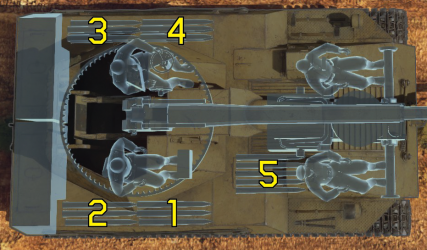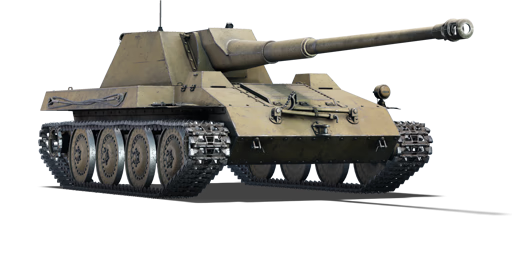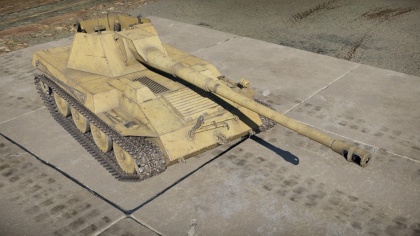Waffentrager
Contents
Description
The Waffenträger Krupp-Steyr mit Pak 43 is a rank III German tank destroyer
with a battle rating of 5.7 (AB/RB/SB). It was introduced in Update 1.71 "New E.R.A.".
General info
Survivability and armour
Armour type:
- Rolled homogeneous armour
| Armour | Front (Slope angle) | Sides | Rear | Roof |
|---|---|---|---|---|
| Hull | 10 mm (76°), 20 mm (46°) Front glacis 5 mm (46°) Engine grille 20 mm (44°) Lower glacis 10 mm (46°) Crew ports |
10 mm (25°) Top 10 mm Bottom |
10 mm (26°) Top 10 mm (15°) Bottom |
5 mm |
| Turret | 20 mm (41°) Turret front 20 mm (5-46°) Gun mantlet |
10 mm (22-24°) | 10 mm (24°) | N/A |
Notes:
- Suspension wheels are 20 mm thick and tracks are 30 mm thick.
- Belly armour is 5 mm thick.
- A 10 mm structural steel plate covers the engine from the crew.
Mobility
| Game Mode | Max Speed (km/h) | Weight (tons) | Engine power (horsepower) | Power-to-weight ratio (hp/ton) | |||
|---|---|---|---|---|---|---|---|
| Forward | Reverse | Stock | Upgraded | Stock | Upgraded | ||
| Arcade | 38 | 8 | 16.3 | 199 | 267 | 12.21 | 16.38 |
| Realistic | 35 | 7 | 124 | 140 | 7.61 | 8.59 | |
Armaments
Main armament
| 88 mm PaK43 | Turret rotation speed (°/s) | Reloading rate (seconds) | |||||||||||
|---|---|---|---|---|---|---|---|---|---|---|---|---|---|
| Mode | Capacity | Vertical | Horizontal | Stabilizer | Stock | Upgraded | Full | Expert | Aced | Stock | Full | Expert | Aced |
| Arcade | 30 | -8°/+45° | ±180° | N/A | 11.33 | 15.68 | 19.04 | 21.06 | 22.40 | 11.05 | 9.78 | 9.01 | 8.50 |
| Realistic | 8.33 | 9.80 | 11.90 | 13.16 | 14.00 | ||||||||
Ammunition
| Penetration statistics | |||||||
|---|---|---|---|---|---|---|---|
| Ammunition | Type of warhead |
Penetration @ 0° Angle of Attack (mm) | |||||
| 10 m | 100 m | 500 m | 1,000 m | 1,500 m | 2,000 m | ||
| PzGr 39/43 | APCBC | 237 | 234 | 222 | 207 | 194 | 181 |
| PzGr 40/43 | APCR | 279 | 273 | 252 | 227 | 205 | 185 |
| Hl.Gr 39 | HEAT | 110 | 110 | 110 | 110 | 110 | 110 |
| Sprgr.43 | HE | 14 | 14 | 14 | 14 | 14 | 14 |
| Shell details | |||||||||
|---|---|---|---|---|---|---|---|---|---|
| Ammunition | Type of warhead |
Velocity (m/s) |
Projectile Mass (kg) |
Fuse delay (m) |
Fuse sensitivity (mm) |
Explosive Mass (TNT equivalent) (g) |
Ricochet | ||
| 0% | 50% | 100% | |||||||
| PzGr 39/43 | APCBC | 1,000 | 10.16 | 1.2 | 14.0 | 108.8 | 48° | 63° | 71° |
| PzGr 40/43 | APCR | 1,130 | 7.3 | N/A | N/A | N/A | 66° | 70° | 72° |
| Hl.Gr 39 | HEAT | 600 | 7.64 | 0.0 | 0.3 | 1,100 | 62° | 69° | 73° |
| Sprgr.43 | HE | 820 | 9.4 | 0.1 | 0.5 | 1,000 | 79° | 80° | 81° |
Ammo racks

| Full ammo |
1st rack empty |
2nd rack empty |
3rd rack empty |
4th rack empty |
5th rack empty |
Recommendations | Visual discrepancy |
|---|---|---|---|---|---|---|---|
| 30 | 26 (+4) | 21 (+9) | 16 (+14) | 11 (+19) | 1 (+29) | Right side empty: 21 (+9) | No |
Usage in battles
Despite its fully-traversable turret, the Waffenträger is a classic tank destroyer. It has a fantastically powerful gun, which can defeat any heavy tank at this tier, even at long ranges. The shells have great penetration, great explosive filler, and very good velocity. The vehicle even has a better-than-average reload speed. (Note: keep in mind that the Waffenträger is not equipped with any machine guns.)
However, this vehicle also has poor mobility. It's just slow (both forwards and in reverse), especially when stock, and acceleration is poor as well. The tank struggles on slopes, and is completely unsuited for close-up brawling. Another downside to this vehicle is its poor armour setup. Although the armour protection can defend against machine gun fire, any cannon shell will penetrate with ease. The vehicle may also be hullbroken by significantly large shells. And finally, the open-top turret compartment is vulnerable to aircraft and artillery fire. Therefore, it may be necessary to work with SPAA teammates and to find cover under trees or behind buildings.
Given the vehicle's advantages and disadvantages, a good way to play this vehicle is often in a sniping play-style. Staying hidden, keeping distance, and only exposing the vehicle in order to shoot capitalizes on the strength of the vehicle's gun while minimizing the effects of its weak armour. Additionally, it is very easy to hide this vehicle behind cover in a hull-down position, since it has a low profile and good gun depression.
Alternatively, it may also be beneficial to employ a more ambush-based playstyle with this vehicle. But since this requires more close-up engagements, be careful to avoid lengthy brawls, where the Waffenträger's poor armour and mobility will hinder it greatly. Positioning is still very important. Finally, it may be sometimes possible to engage the enemy while orienting the vehicle sideways or backwards. This protects the engine and transmission from enemy fire, and prevents the protruding frontal optics ports from interfering with gun traverse and depression.
Modules
| Tier | Mobility | Protection | Firepower | ||
|---|---|---|---|---|---|
| I | Tracks | Parts | Horizontal Drive | ||
| II | Suspension | Brake System | FPE | Adjustment of Fire | Hl.Gr 39 |
| III | Filters | Crew Replenishment | Elevation Mechanism | ||
| IV | Transmission | Engine | PzGr 40/43 | ||
After the Parts modification, the most useful upgrades are the Horizontal Drive, Adjustment of Fire, and Mobility modules.
Pros and cons
Pros:
- 88 mm PaK 43 gun power can destroy any vehicle it meets
- Full rotating turret with the powerful gun
- Decent -8° gun depression for hull-down positions
- Low profile construction makes the vehicle easily conceal
- Suspension and tracks cover a good portion of the lower side hull for protection
- All AP and APHE shells over-pierce the tank without dealing much damage due to the very thin armour
Cons:
- Open-top turret crew vulnerable to shrapnel, machine guns, air strikes, artillery, and such
- Gun recoil can jump the vehicle dramatically, throwing off the aim and bouncing the vehicle position
- Very thin overall armour of between 10-20 mm
- 5 mm roof armour means an aerial attack is deadly
- 5 mm belly armour makes any HE shots able to penetrate through the bottom
- Front-mounted engine and transmission means both can be knocked out with a front shot, immobilizing the vehicle
- Poor acceleration
History
Development
In as early as 1942, the German Wehrmacht was looking for a way to make large anti-tank guns easier to deploy and transport, but also should be able to fire the gun and fight on the front lines. Four major German companies (Krupp, Rheinmetall, Borsig, and Ardelt) took part in a tender of the Waffenamt (German Army Weapons Agency) in 1943 for the project. Then, in April 1944, the four companies presented their prototypes. With Krupp and Steyr working together on a design, and Rheinmetall and Borsig on their own. Both designs envisaged placing the 8.8 cm PaK 43 L / 71 in a lightly armoured, upwardly open, rotatable tower mounted on a hull of a Raupenschlepper Ost (a tracked artillery mover) to keep costs down and reduce complexity. However, the decision was made for the prototype of the last company, Ardelt, therefore making the Krupp-Steyr design unwanted by the Waffenamt.
Combat usage
A few Waffenträgers were fielded in the attack on Potsdam in April 1945.
Media
See also
Links to the articles on the War Thunder Wiki that you think will be useful for the reader, for example:
- reference to the series of the vehicles;
- links to approximate analogues of other nations and research trees.
External links
| Germany tank destroyers | |
|---|---|
| Pz. I Derivatives | Panzerjäger I |
| Pz. II Derivatives | 15cm sIG 33 B Sfl |
| Pz. 38(t) Derivatives | Marder III · Marder III H · Jagdpanzer 38(t) |
| Pz. III Derivatives | StuG III A · StuG III F · StuG III G · StuH 42 G |
| Pz. IV Derivatives | Jagdpanzer IV · Panzer IV/70(A) · Panzer IV/70(V) · Dicker Max · Nashorn · Brummbär · VFW |
| Pz. V Derivatives | Jagdpanther G1 · Bfw. Jagdpanther G1 |
| Pz. VI Derivatives | Sturer Emil · Elefant · Ferdinand · 38 cm Sturmmörser · Jagdtiger |
| Wheeled/Half-track | 8,8 cm Flak 37 Sfl. · Sd.Kfz.251/9 · Sd.Kfz.251/10 · Sd.Kfz.251/22 · Sd.Kfz.234/3 · Sd.Kfz.234/4 · 15 cm Pz.W.42 |
| ATGM Carrier | RakJPz 2 · RakJPz 2 (HOT) · Wiesel 1A2 |
| Other | Waffenträger · M109G · JPz 4-5 · Raketenautomat · VT1-2 |





